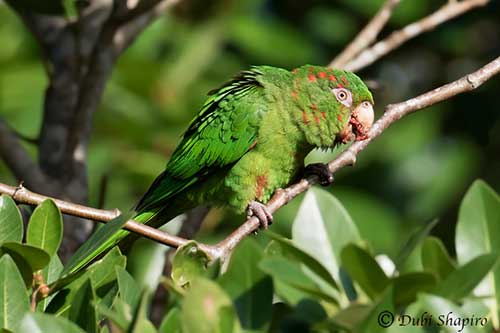
RANGE:
The Cuban Parakeet is confined to some remote areas of Cuba. It can be found in Zapata Peninsula, Trinidad Mts, Sierra de Najasa and some areas in the E mountain range.
This species has been extirpated from the W provinces (excluding Zapata) and Isle of Pines. It disappeared from most of its former range by the late 1800s.
HABITAT:
The Cuban Parakeet occurs in woodlands but it favours the forest edges, especially along watercourses. It frequents savannas with scattered palm groves and tree stumps near swampy areas.
CALLS AND SONGS: SOUNDS BY XENO-CANTO
The Cuban Parakeet gives repeated, loud “crick-crick-crick” in flight. While perched, it also utters a low, whisper-like note, also heard when the bird is feeding.
During nest defence against other pairs, they give loud screeches.
BEHAVIOUR IN THE WILD:
The Cuban Parakeet feeds on a wide variety of seeds and fruits. It also consumes leaves, pods, flowers and flower buds, pollen and nectar.
During the breeding season, it feeds primarily on Zanthoxylum martinicense which local name is “ayúa”. It takes the green and ripe fruits of Manguifera indica, and the green and tender fruits of the royal palm (Roystonea regia) for the seeds. But numerous tree species are regularly visited. It usually forages in small groups or in family parties.
The Cuban Parakeet was formerly considered a crop pest, as it was feeding on flowers and fruits of oranges, heads of maize and berries of coffee. This behaviour has involved persecution from humans.
Like almost all the Psittacidae, the Cuban Parakeet is a cavity nester. It may also build its nest in arboreal termite nests, and mainly active ones.
It is probably monogamous with long term pair bonds. Both mates strengthen the pair bonds by feeding and preening together.
The Cuban Parakeet is sedentary in Cuba, but some altitudinal movements are reported from Trinidad Mts after the breeding season.
The flight is fast and direct, with rapid wingbeats.
REPRODUCTION OF THIS SPECIES:
The breeding season takes place between March and August, during the peak of productivity of the fruiting trees.
The Cuban Parakeet usually nests in tree holes, and often abandoned nests by woodpeckers, mainly the Cuban Green Woodpecker. However, it also uses, but less frequently, the nests of arboreal termites, and prefers active nests.
The nest is placed between 4 and 15 metres above the ground, often in dead palm. The bottom of the cavity is usually covered with wood chips that both adults and chicks rip off from inside the hole.
The female lays 2-5 white, almost round eggs. The incubation lasts 23-25 days. The chicks are fed mainly by the female which is fed by its mate. They have pale grey down, but the first feathers appear about ten days after hatching. They leave the nest about 45-50 days after hatching.
PROTECTION / THREATS / STATUS:
The Cuban Parakeet is persecuted as a crop pest, and it is threatened by habitat loss and trapping for pet trade, the latter becoming now insignificant. The loss of the nesting trees is a result of hurricane damage in 1996.
The population is estimated to number 1,500/7,000 mature individuals, and it is suspected to be declining.
The Cuban Parakeet is currently classified as Vulnerable.
Fr: Conure de Cuba
Ang: Cuban Parakeet
All: Kubasittich
Esp: Aratinga Cubana
Ita: Parrocchetto di Cuba
Nd: Cubaanse Aratinga
Sd: kubaparakit
Text by Nicole Bouglouan
Photographer:
Dubi Shapiro
Dubi Shapiro Photo Galleries
Sources:
HANDBOOK OF THE BIRDS OF THE WORLD vol 4 by Josep del Hoyo-Andrew Elliott-Jordi Sargatal - Lynx Edicions - ISBN: 8487334229
PARROTS OF THE WORLD – An Identification Guide – by Joseph M. Forshaw – Princeton University Press – ISBN 0691092516
BIRDS OF THE WEST INDIES – by Herbert Raffaele, Kristin Williams et Tracy Pedersen – Helm – ISBN: 9780713649055
Neotropical Birds – Cornell Lab of Ornithology
Arthur Grosset's Birds (Arthur Grosset)
Cuban Parakeet
Psittacara euops
Psittaciformes Order – Psittacidae Family
INTRODUCTION:
The Cuban Parakeet is endemic to Cuba where it is now confined to some parts of the island. It was formerly on the Isle of Pines too.
This species has become very rare, following habitat loss, persecution and trapping for cage bird trade.
DESCRIPTION OF THE BIRD:
Biometrics:
Length: 26 cm
Weight: 90 g (78-96 g)
The Cuban Parakeet is a small, green Psittacidae with scattered red feathers on head, neck sides and underparts. The upperparts are entirely green. The lesser underwing-coverts and the edge of the wing are red. The greater underwing-coverts and the underside of the flight-feathers are olive-yellow. The graduated tail is green above and olive-yellow below.
On the green head, we can see a prominent, broad, white eyering.
The bill is pale horn. The eyes are whitish to pale yellow. Legs and feet are pinkish-brown.
Male and female are similar.
The juvenile resembles adult, but it lacks the scattered red feathers. The underwing-coverts have less red and the carpal edge is yellowish-green. It has brown eyes.
